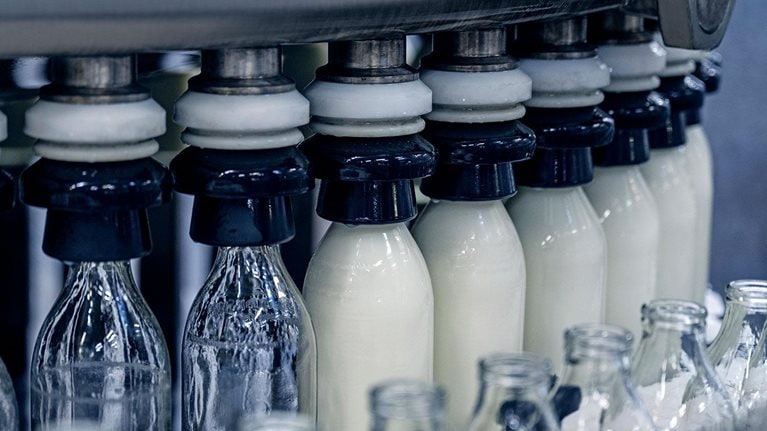As the global population grows, agriculture systems everywhere must find ways to feed humankind sustainably. The US dairy industry is no exception. C-suite and environmental, social, and governance (ESG) leaders in the sector are shaping dairy’s path to a sustainable future, but at the same time, they are being asked to account for new innovations, regulations, and economic factors.
To gain insight into how dairy executives’ priorities have shifted over time, McKinsey and the International Dairy Foods Association conducted their sixth annual survey of dairy executives in fourth quarter 2023 (see sidebar, “About the research”).1 In interviews and responses to survey questions, respondents shared what excites them about dairy, emerging challenges in the sector, and more.
A number of new findings emerged from this survey. The previous survey showed that concerns were divided between growth, resilience, and sustainability, but sustainability has moved to the center of the conversation. We have seen progress on sustainability commitments and actions, but challenges with addressing farm-level emissions remain. Other findings indicate that although there is much work to be done, dairy executives are optimistic about the future of the industry.
What excites leaders in dairy?
Executives expressed excitement about many aspects of the dairy industry, from international opportunities to novel technologies. As in the 2022 survey, a few topics stood out during our interviews: growth, product nutrition, and innovation (Exhibit 1).

Growth
Dairy executives were most excited about growth, including growth in the industry, companies, and consumer demand. More than half of the executives we interviewed talked about the potential for growth, and more than 40 percent cited growth as their top source of excitement. This share of executives is similar to that of the 2022 survey, reflecting the sector’s overall momentum: the retail value of the overall dairy market in the United States grew by 9 percent from 2021 to 2022 and by 7 percent from 2022 to 2023.2 According to our interviews, much of this growth was driven by pricing, though executives expect future growth to be propelled more by volume. Growth forecasts vary by product, but dairy overall is expected to grow 4 percent annually from 2024 through 2027, with most growth coming from cheese and yogurt.3
Dairy is just scratching the surface of unlocking value for consumers around the world.
Product nutrition and innovation
Almost 30 percent of dairy executives we interviewed were most excited about the nutrition or “goodness” of their products, from the high nutrient density of yogurt to the potential for dairy protein ingredients. In addition, one-third of the executives we interviewed were excited about product innovations that allow them to better harness the nutrition of dairy. Excitement about innovation is not new—as far back as the 2018 Executive Sentiment Survey, product innovation was the second-most-cited response to the question, “What do you believe is your company’s top source of competitive advantage?” (17 percent).
What keeps dairy leaders up at night?
Although there is much to be excited about in dairy, industry leaders do not wear rose-tinted glasses when looking toward the future. When we asked dairy leaders about their biggest concerns (what keeps them up at night), the most frequent answers were sustainability and regulation (Exhibit 2).

Sustainability
When asked what keeps them up at night, executives were most likely to cite sustainability (19 percent of interviewees). About three-quarters of survey respondents said their sustainability efforts are motivated by their customers (retailers and other dairy vendors), and just under half said the same of consumers. This finding is relatively consistent with 2022 results. However, interviewed executives said that consumers may not be willing to pay more for sustainable products, raising understandable concerns about the costs associated with decarbonization and other sustainability initiatives. Still, some signals suggest that ESG could be growing in importance for consumers. In a recent joint analysis with Nielsen IQ, McKinsey found that yogurt and cheese products with ESG-related claims outperformed products without those claims.4
Consumers are extremely interested in sustainability, but they are not necessarily willing to pay more. I’m not sure if this will ever change. People will tell you they are willing to pay for it, but they won’t.
Great progress has already been made in reducing the carbon intensity of dairy. In the United States, emissions per kilogram (kg) of milk dropped by 27 percent from 1995 to 2015, from 0.75 kg CO2 equivalent (CO2e) per kg of milk to 0.55 kg CO2e per kg of milk.5 However, US dairy production has outpaced this rate of change (a 34 percent increase over the same period to 208 billion pounds), resulting in increased emissions overall.6 There also remains great uncertainty about how to address Scope 3 emissions—that is, upstream emissions outside a company’s direct operational control, such as enteric emissions from cows and emissions from manure.7 Scope 3 emissions are inherently difficult to measure, particularly at the farm level.
One challenge when it comes to sustainability is how we control the cost, from carbon credits to biodigesters. The more go-betweens you have between the farmer and the processor, the more expensive it gets.
Regulation
Many dairy leaders also cited regulation as a topic on their minds (13 percent). This makes sense, given that in the United States, national legislation affecting the dairy industry, including the Federal Milk Marketing Orders and the Farm Bill, have recently and will be revisited and renewed. Of particular interest is the Farm Bill, which covers a large suite of conservation programs and associated funding, including the $18 billion expansion of funds granted in the Inflation Reduction Act for agricultural practices that can mitigate and reduce greenhouse gas emissions (GHG). In addition, on March 6, 2024, the US Securities and Exchange Commission adopted rules to enhance and standardize climate related disclosures, adding pressure on sustainability transparency.8
The past few years have also seen new environmental regulations concerning dairy. For example, California Senate Bill 1383, enacted in 2020, requires dairies to reduce methane emissions by 40 percent from 2013 levels by 2030. Dairy leaders are also looking at environmental regulation abroad and considering what the impact could be if the United States follows suit. Examples include the European Green Deal and New Zealand’s upcoming carbon tax on farm emissions.
What priorities have changed in importance?
Since the 2022 survey, dairy executives’ leading priorities have shifted toward ESG topics. Talent saw the biggest increase in priority, rising from fourth to second place (Exhibit 3). Sustainability experienced the second-highest increase (sixth to fifth place), trading places with supply chain, one of 2022’s critical topics.

Talent
In the 2023 interviews, 45 percent of executives noted that talent is less of a concern now than it was in the past few years. This may be because leaders were particularly concerned about talent in 2022, with about 70 percent of executives sharing their concerns about labor in 2022 interviews. However, survey results indicate that the past year’s concern is this year’s strategic priority: in 2023, 60 percent of executives cited talent as a strategic priority, moving it two places up the rankings.
We also noted a shift in how executives view the labor challenge. One executive said, “It is more a generational change. I doubt the new people we hire will retire here.” In fact, a 2022 McKinsey survey of 1,763 Gen Z Americans (aged 18 to 24) found that 77 percent of them are searching for a new job.9 At the same time, dairy companies are trying to make the workplace more appealing to potential employees. Our interviews with dairy leaders revealed three common approaches to managing labor issues: compensation, culture, and process. Dairy companies are considering increasing wages and benefit packages, focusing on company culture, and investing in operational technology to help attract and retain talent.
We are focusing on making this a great place to work, connecting to purpose and values.
Environmental sustainability
In addition to keeping executives up at night, sustainability is a strategic priority. For example, 60 percent of processors said that reducing GHG emissions was a top three issue in their sustainability strategy, particularly since addressing Scope 3 and farm-level emissions is so challenging. According to our survey, 71 percent of companies are measuring farm emissions, but only 27 percent are changing procurement based on emissions, and an even smaller portion—7 percent—are mandating that farms inset their emissions reductions (rather than sell outside the value chain).
Sustainability is very high on our agenda. A mentality shift is needed to decarbonize the industry, and for a while, there has been talk but no action. Now we are seeing things intensify.
Companies are also considering their impact on natural capital. Forty-five percent of companies cited water usage as a top three issue in their sustainability strategy. And when asked about how they are addressing nature and natural capital, 44 percent said they were sourcing feed grown with regenerative-agriculture practices, and 20 percent said they were incorporating recommendations from the Taskforce on Nature-related Financial Disclosures.
To build and enact sustainability strategies, almost 90 percent of the surveyed dairy companies currently have a sustainability or ESG lead on staff. Of these leads, 77 percent are dedicated full-time employees, up from about 60 percent in 2022. These sustainability leaders will need their companies to support them in taking concrete actions if they want to reach net-zero emissions.
What’s next?
Moving forward, sustainability looms large. Indeed, decarbonization of the dairy industry is already intensifying. At the UN Climate Change Conference (COP28) in 2023, several dairy companies (representing about 5 percent of global milk intake) announced the formation of the newly established Dairy Methane Action Alliance. This effort builds on prior industry sustainability efforts, such as the US Dairy Net Zero Initiative, launched in 2020.10 Members of the Dairy Methane Action Alliance plan to address methane from across their dairy supply chains, including Scope 3 emissions.11
Alongside sustainability, companies are taking steps to address labor needs and a challenging inflationary environment, which will likely remain necessary for the foreseeable future. As we look to 2024 and beyond, executives should consider the following areas:
- A path to net zero, including measuring and addressing Scope 3 emissions, is complex. Meeting the dairy industry’s goal of net zero by 2050 will require industry-wide alignment and meaningful actions, such as working with farms to reduce emissions via initiatives like manure management or novel feed additives. Companies can help push the industry forward by building out transparency and measurement capabilities, such as via integrated enterprise resource planning systems (ERPs).
- The forces pushing sustainability in the industry include consumer preferences, shareholder and lender pressure, and regulatory action. Companies should carefully track shifts across these dimensions and stay ahead of trends and requirements.
- The labor market is shifting. Taking steps to appeal to the current generation of workers will be critical. This may include offering flexible work schedules and staying up to date on best-in-class benefit offerings.
With exciting prospects on the horizon, the dairy industry has an opportunity to seize the moment and develop a more sustainable approach to dairy production. Global pushes such as the newly announced Dairy Methane Action Alliance, requirements from shareholders and retailers, and consumer preferences mean that the time is now for the dairy industry to develop a unified plan to tackle some of its biggest sustainability obstacles. If leaders can lean into innovations and make progress on emissions, they can set themselves up well in the years to come.


